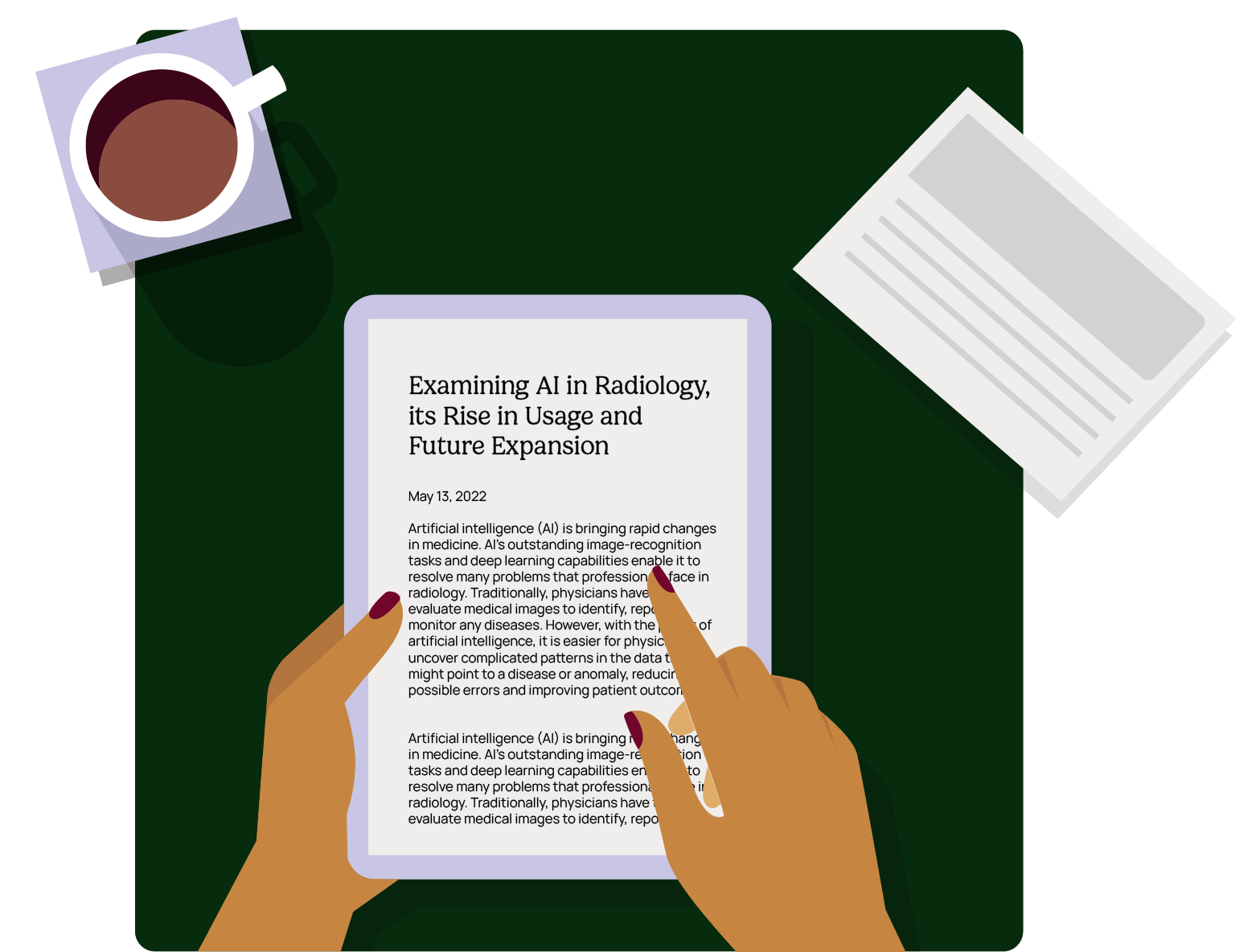May 13, 2022
Artificial intelligence (AI) is bringing rapid changes in medicine. AI’s outstanding image-recognition tasks and deep learning capabilities enable it to resolve many problems that professionals face in radiology. Traditionally, physicians have to evaluate medical images to identify, report or monitor any diseases. However, with the power of artificial intelligence, it is easier for physicians to uncover complicated patterns in the data that might point to a disease or anomaly, reducing possible errors and improving patient outcomes.
Artificial intelligence (AI) is bringing rapid changes in medicine. AI’s outstanding image-recognition tasks and deep learning capabilities enable it to resolve many problems that professionals face in radiology. Traditionally, physicians have to evaluate medical images to identify, report or monitor any diseases. However, with the power of artificial intelligence, it is easier for physicians to uncover complicated patterns in the data that might point to a disease or anomaly, reducing possible errors and improving patient outcomes.
We will go into depth about how AI is revolutionizing the radiology field and how it can create a positive impact on the future. We will also address the pros and cons, discuss the usage of AI, and what we can expect to see in the future from AI. Let’s start by understanding the rise of AI in radiology.
The Rise of AI Usage in Radiology
The debate regarding AI’s usage in radiology is similar to those in other fields. Practitioners have a concern regarding its accuracy as well as whether there is a risk that they will lose their jobs. In fact, the usage of AI in radiology is to enhance the capabilities of practitioners rather than replace them.
Nevertheless, a recent survey with the members of the European Society of Radiology shows the respondent’s answers regarding the AI’s impact on:
- Job opportunities
- Reporting workload
- Radiologist’s profile
- Radiologist-patient relation
- Time-saving
- Supervision
- Task definition
- Image labeling
- Current usages levels of AI in radiology
The survey shows the growing importance of AI in radiology. A key takeaway from the survey is 30% of the respondents are planning to use AI in radiology, while 20% are already using it.
The CDC also addresses the growing use of machine learning and AI in healthcare. All in all, we can say that these studies and reports show an increasing adoption of AI in radiology.
Related: Radiology Solutions
Pros & Cons
Like most new technologies, the usage of AI in radiology comes with some pros and cons. Let’s go over the pros of it first.
Pros
Here are some of the benefits of AI in the healthcare industry:
Saves time and resources
Al is proving to be cost-effective for every industry that is adopting it. The same is the case with the healthcare industry, which can save billions of dollars using AI. Automation allows hospitals and medical institutes to save time and resources for many tasks. Medical institutions can use these resources to focus on improved patient care.
Moreover, natural language processing and deep learning enable physicians to review cases more efficiently and effectively. For example, it can take hours for doctors to review a patient’s history and gather needed information about them. AI tools can help streamline this process, reducing the time needed to complete typical administrative tasks.
Reduce workload by handling tedious tasks
Apart from saving time and resources, AI also helps reduce workload by streamlining repetitive tasks, such as:
- Scheduling an appointment
- Summarizing clinical points
- Tracking patient records
As an example, AI streamlines repetitive tasks such as finding visual markers for later evaluation, saving the radiologist time that can be spent analyzing the results and reporting them.
AI can identify issues or mistakes that typically would result in insurance denying a claim and correcting the error in advance, reducing the chance of the claim having to be resubmitted. This reduces caregiver workload and improves the patient experience.
Help identify anomalies for radiologists
One of the crucial elements in treating any medical issue is having accurate data, which is vital for medical professionals to be able to make an accurate diagnosis. AI can improve the overall accuracy of diagnoses by identifying possible anomalies that otherwise would have been missed. In fact, studies show that AI has helped radiologists improve their performance compared to work without the benefit of AI.
Making better-informed decisions
Concise and clear data will enable doctors to make better-informed decisions about the care of their patients. AI has the ability to be integrated with the physician’s workflow to manage images and reporting, reducing their workload while increasing their accuracy. With the help of AI, they can reduce tedious and time-intensive tasks while focusing on their patients.
Cons
Now that you know the pros of AI in healthcare, let’s go over some cons:
Lack of fully understanding the physician’s workflow
One of the biggest negatives associated with AI technology in radiology is its inability to fully comprehend the physician’s workflow. It can miss out on some vital information that can lead to misdiagnosis and or other problems.
Requires human interaction
Even though there is little human interaction necessary for AI, we cannot eliminate the factor of human involvement. It is one of the hurdles in implementing AI in the radiology field. In fact, there are abilities such as relying on experience and instinct that are uniquely human and, at least today, irreplaceable.
Susceptible to security risks
Anything in the digital world is potentially subject to cyber threats and attacks. This includes AI systems, which require a robust cyber security framework to ensure data security and patient privacy.
Since Artificial Intelligence uses the information that helps systems become more authentic, there is a chance cybercriminals might use it for their benefit. As such, it is vital for healthcare providers to use the most effective and powerful online security measures possible.
Adoption of AI
AI is gradually seeing adoption in highly developed countries. However, many physicians are still not fully utilizing artificial intelligence. As per a survey conducted to find the radiologists’ understanding of AI’s use in diagnostic radiology, 76 participants were not using AI at all.
Moreover, many studies and articles point out how AI is not delivering the results many expect from it. The prime reason is the lack of awareness and knowledge regarding the technology. Therefore, we can conclude that the adoption of AI in radiology is happening but not at a rapid pace.
AI in Use Today
We can see the technology’s usage in various places. An example of this is the usage by Bibb Allen, MD, FACR, and CMO of the ACR’s Data Science Institute (DSI), who tells that AI-lite is in action for many items such as:
- Auto-segmentation of different body parts in 3D post-processing
- Computer-aided detection for cancer
- Consultation of most suitable procedures for recommendations
- Natural language processing to streamline crucial results reporting
- Quantification and kinetics in post-processing
In addition to this, AI streamlines the process and helps practitioners in many different ways. Here are some ways it enables technicians to make the best decisions:
- Helps in monotonous or repetitive duties
- Discovering anomalies
- Staying resistant to distractions
- Processing immense quantities of data in a short time
Furthermore, the American College of Radiology research shows that AI saw rapid adoption in radiology. It stated that the clinical adoption of AI in radiology went from zero to 30% within five years from 2015 to 2020. According to this study, the industry is embracing AI in radiology, and those medical institutions and physicians who embrace it will emerge victorious in the long run. Nina E. Kottler, MD, MS, vice president of clinical operations and associate chief medical officer of clinical AI at Radiology Partners claims, “radiologists are not going to be replaced by AI, but radiologists who use AI and understand AI, will replace those who don’t.”
AI Expansion in the Near Future
We can expect to see the use of AI in radiology increase soon. Many studies show how it can transform the process and make it easier for doctors and physicians to focus on other things. In addition, they can get a better understanding of the disease they are dealing with.
Nevertheless, there are a few hurdles that the health care industry needs to look at before implementing AI in radiology effectively. Moreover, institutes will have to increase the awareness about it among their doctors, physicians, and paramedic staff.
A significant number of doctors who don’t have the proper understanding of AI can influence the department of radiology. Also, their concerns need to be addressed, so the doctors can use AI in the best possible manner for the treatment and diagnosis of their patients.
In Summary
While there are a few problems in integrating AI technology in radiology, the future belongs to AI. Various industries are using it for their benefit, and it is helping them yield fruitful results.
As for the healthcare industry, there are still some key developments that it will have to go through before implementing AI, especially for radiology, but it holds a promising future. For a demonstration of AI in action, schedule a time with our sales team.





